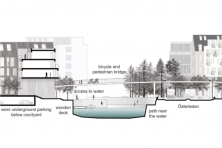A Blue Entrance - to the City in the Sea
Karlskrona (SE) - Lauréat
DONNÉES DE L’ÉQUIPE
Représentant d’équipe : Magnus Haahr Nielsen (DK) – architecte and urbaniste
Associé: Stefan Jesper Gründl (DK) – architecte
Birkedommervej 16, 2. th, 2400 Copenhagen (DK)
+45 28713580 – magnus.haahr.nielsen@gmail.com
Voir la liste complète des portraits ici
Voir la page du site ici

Magnus Haahr Nielsen et Stefan Jesper Gründl
INTERVIEW en anglais
Cliquer sur les images pour les agrandir
1. How did you form the team for the competition?
We know each other from the academy in Copenhagen where we studied together. After graduation we went different ways, one took a job in a municipality and the other went to an architectural firm. So with our shared academic background and our different approaches from work experience we formed a strong team.
2. How do you define the main issue of your project, and how did you answer on this session main topic: the place of productive activities within the city?
Karlskrona has a unique location in the Swedish archipelago. Situated on islets in the sea Karlskrona historically served as a naval base of Sweden. We have been inspired by the relationship between the city and the topography as it is the historical premises and the very essence of the city. In the same way, the site previously used as an oil harbour is reasoned due to its proximity to the sea. The land reclamation ground facilitating the oil harbour - and the overall historical foundation of the city, as a city in the sea, was obvious contradicting elements that had to be resolved within the project answer. The site has a long history of production, it is even more obvious due to the names historically given to the isles of Hattmakareholmen and Skomakarholmen. These names are referring to the craftsmanship of making hats and shoes. When the industrialization reached the area, it was turned into an oil harbour and today several of its current residents are in the productive manor as well. So in that way, we felt it was natural to integrate the productive activities into the heart of the urban fabric, primarily focusing on the ground floor, to secure a future mixed-use programme of the urban district with a high density of housing. Thereby also relating to the sites historical and present use as a productive site.
3. How did this issue and the questions raised by the site mutation meet?
We wanted to address the issue of the sites conflicting identities without erasing the story of their industrial past. At the same time, we wanted to reestablish the overall relationship to the sea and the historical landscape. In conclusion, we focused on doing a reinterpretation of the sites overlapping historical layers giving attention and physical space to both the distant history, the recent history and the present.
4. Have you treated this issue previously? What were the reference projects that inspired yours?
The topics linked to the productive cities can be seen in relation to a series of our individual study projects dealing with the city as a story-telling layered entity. In our previous projects, we have in different ways worked with a reindustrialization of the city that has become possible by the introduction of small-scale and low-pollution productive methods.
5. Urban-architectural projects like the ones in Europan can only be implemented together with the actors through a negotiated process and in time. How did you consider this issue in your project?
We specifically addressed this aspect by working with an overall strategic concept that has a high flexibility within the framework of the key element. The proposal can thereby adapt to new or changing demands in the coming planning and realization process. Furthermore, the project supports the notion of a phase format that allows a sectional and layered implementation.
6. Is it the first time you have been awarded a prize at Europan? How could this help you in your professional career?
This is the first major competition we have done together. So it is an honour and a privilege to be awarded the first prize and therefore we also consider it to be a mile pole in our professional careers. First of all, we want to contribute to the development of the project site in Karlskrona over the coming years. Furthermore, we hope this will be an opportunity for us to influence the debate in regards to urban planning and architectural values in general.








